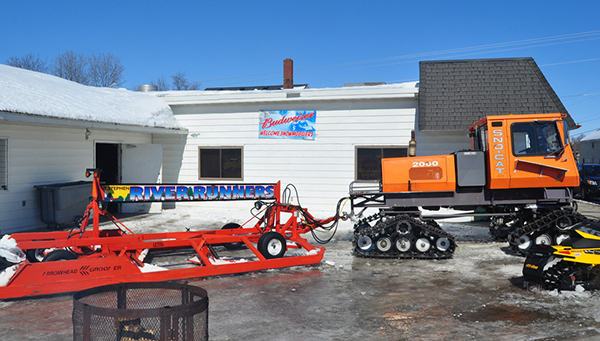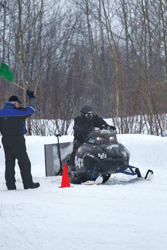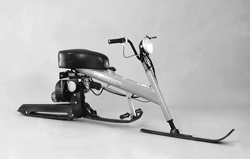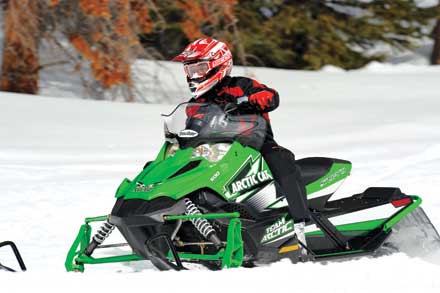 The kit on Hauck’s sled included the GHT-R-Dun exhaust silencer, a stainless steel Y-pipe, a jet kit, a K&N Power Up Kit and his No. 6 clutch kit. In addition, his machine had a different CDI box that adjusts the rev limiter from stock. Hauck advertises that the upgrades shave 16 pounds and puts about 15 more horsepower on the ground with the enhancements and the CDI revision.
The kit on Hauck’s sled included the GHT-R-Dun exhaust silencer, a stainless steel Y-pipe, a jet kit, a K&N Power Up Kit and his No. 6 clutch kit. In addition, his machine had a different CDI box that adjusts the rev limiter from stock. Hauck advertises that the upgrades shave 16 pounds and puts about 15 more horsepower on the ground with the enhancements and the CDI revision.
While we didn’t measure his claims on a dyno, we compared his machine to our stock 2005 RX-1 using our Stalker Radar system.
Our 2005 RX-1 was stock with the exception of a Camoplast Ice Claw track during this comparison. The late-season testing was on a smooth, ice laketop. Hauck’s machine has 144 Woody’s studs, which allowed it to hook up better than our studded Ice Claw.
The first thing we noticed on Hauck’s machine was its superbike sound. The exhaust system exits through the stock rear outlets, but the silencer gives it a throatier snarl. Not surprisingly, it sounds like a piped Yamaha R1 sportbike.
Hauck’s machine pulled stronger, and on the smooth laketop ice it easily reached triple digit speeds. Midrange had more punch, and the engine revved higher making better use of the clutching Hauck had in the machine.
The stock CDI box on an RX-1 has a 10,700 rpm rev limiter. Hauck’s revised mapping has a rev limiter at 12,999 rpm, but Hauck hasn’t hit it, he said. Loads from the clutch keep the engine from reaching that peak.
Measurement
When ready to quantify Hauck’s increased power claims on our radar, we used the same driver on all runs on both machines.
Our best run with our stock RX-1 hit 60 mph in 291.68 feet. By that time, the Hauck machine left our stocker long behind. Hauck’s machine hit the 60 mph mark more than 70 feet sooner.
The added power from the intake and exhaust changes is matched with a clutch kit that helps harness the power. The shifting was as smooth as stock, but a lot more aggressive to help the machine launch better. Speeds were better, too.
At our 1,000-foot radar distance, we captured Hauck’s machine traveling 97.81 mph compared to our stock sled’s 1,000-foot speed of 90.68 mph. From engagement to the 1,000-foot distance, all areas of speed and quickness were improved. At the same distance of 1,000 feet, the GHT-R Dun kit moved Hauck’s RX-1 11.06 seconds. Our stock machine reached the same distance in 11.86 seconds. The .8-second is a big improvement.
While riding Hauck’s machine, it’s easy to feel the added boost. From most any spot in the rev range, when the right thumb pulls heavy into the throttle the sled rocks back, digs in and pulls away with a lot more aggression that stock — and the stock engine on an RX-1 pulls mighty hard already.
The engagement on Hauck’s sled is stronger. The clutching was aggressive and grabbed the belt strong enough at engagement to loft the front of the RX-1. Time from 0-30 mph improved by .29 seconds and 0-60 mph time was reduced by more than a full second.
While a lot of the off-the-line difference can be linked to the better traction of Hauck’s machine, there is no doubt the package made more power. We could feel it while driving the two machines.
Mid-range roll-ons were .23 seconds quicker with Hauck’s upgrades. The 30-50 mph time — a good measurement of corner to corner speeds — was 1.91 seconds on our stocker compared to 1.68 seconds with the GHT-R Dun machine. During these measurements, both machines were off the line and traction wasn’t an issue.
We also ran the two machines on the flat, frozen lake at wide-open throttle. Even with a heavier driver on Hauck’s sled, it pulled away easily at top-end.
Hauck, ever the racer, has a bit of a reputation for doing impromptu drag racing. The word on the street is that he used this “trail” sled to take down many challengers.
“A lot of people think all these four strokes can be beat,” Hauck said. “They find out once in a while that they can get beat [by a four-stroke]. We like to drive around with the guns loaded — just in case.”
It isn’t just turbo kits or nitrous that make four-stroke Yamahas quicker. Hauck’s GHT-R-Dun kit upgrades, as well as the superbike sound, make an RX-1 ready to rumble.




